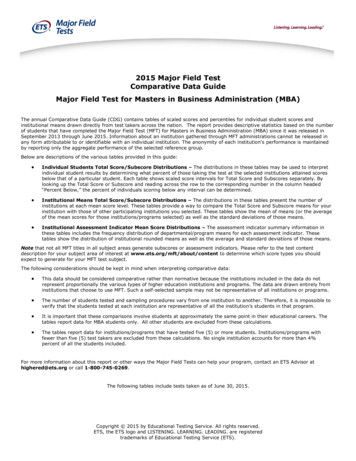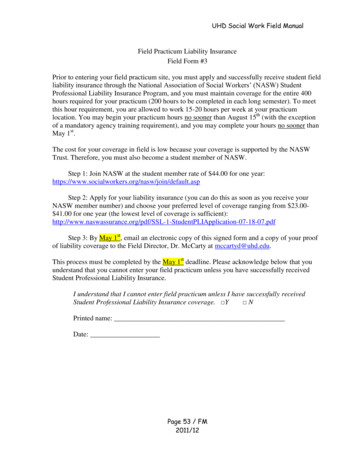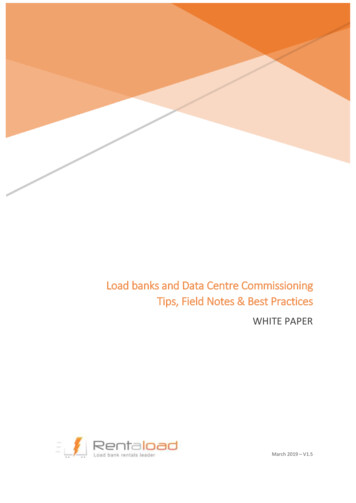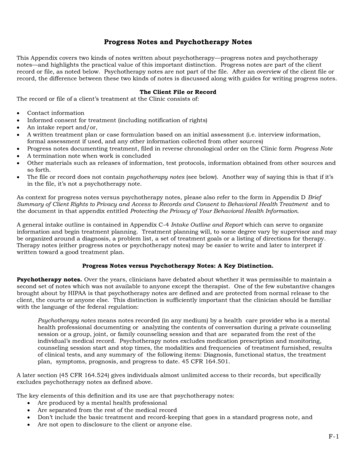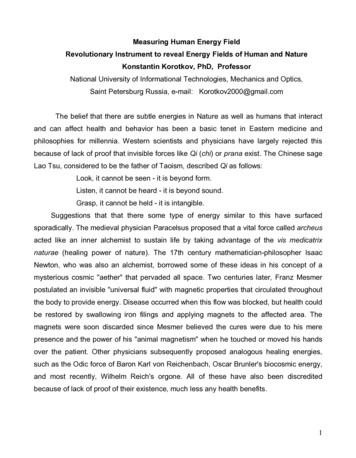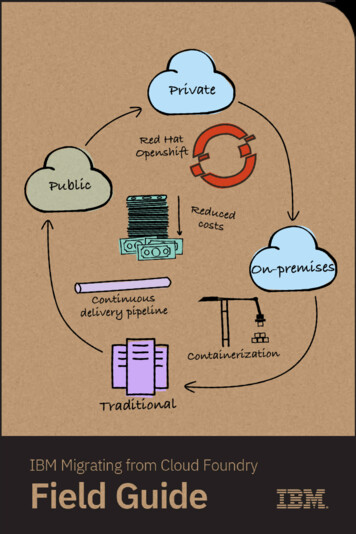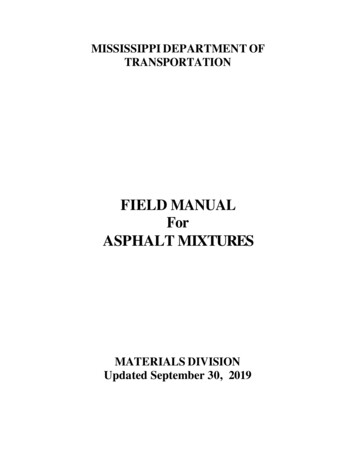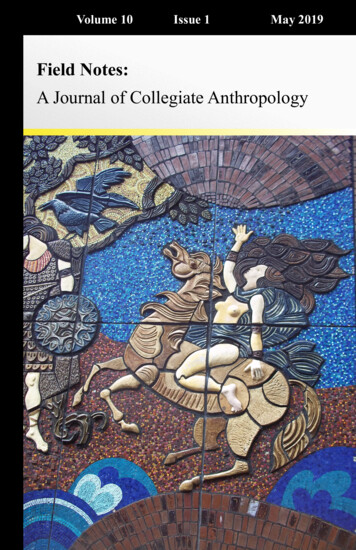
Transcription
Volume 10Issue 1May 2019Field Notes:A Journal of Collegiate Anthropology
Field Notes:A Journal of Collegiate AnthropologyVolume 10Number 1May 2019Published by the Anthropology Student Union (ASU)at the University of Wisconsin–Milwaukee, USAEditors-in-ChiefShaheen M. ChristieEditorial BoardDr. William Balco
Editorial CommitteeRobert AhlrichsAlexander AnthonyAshley BrennamanBecky BuchananB. CharlesMatt DalstromAndrew DicksJosh DriscollAnn EberweinRick EdwardsLara GhisleniElissa HulitSarah JonesCatherine JonesAlexis JordanSammy KailasAllison KotowiczLaya LiebesellerTori PagelCheri PriceAbigael RiceJessica SkinnerLindsey Jo Helms ThorsonDemi VrettasFaculty AdvisorsDr. W. Warner WoodDr. Benjamin CampbellCover DesignAlexis M. JordanArtist Credit: Desmond Kinney (1974)Queen Maeve, Setanta Wall15 Nassau St., Dublin, IrelandField Notes: A Journal of Collegiate AnthropologyUniversity of Wisconsin–MilwaukeeDepartment of Anthropology3413 N Downer Ave390 Sabin HallMilwaukee WI 53211 uwm.edu/org/asu/FieldNotes
Field Notes: A Journal of Collegiate AnthropologyMay 2019Volume 10 (1)Table of ContentsAbout the Contributors6ArticlesGeospatial Considerations Involving Historic GeneralLand Office Maps and Late Prehistoric Bison bisonRemains Near La Crosse, WisconsinAndrew M. Saleh, University of Wisconsin-Milwaukee10Frequency of Costovertebral and CostotransverseOsteoarthritis in the Schroeder Mounds SiteBrian A. Keeling, Illinois State University45Doomed to Die?: An Examination of Demographics76and Comorbidity During the 1918 Influenza Pandemicin Milwaukee, WisconsinAshley L. Brennaman, University of Wisconsin-MilwaukeeA World Without Artists?: In Search of MedievalWelsh Stone-CarversEmily R. Stanton, University of Wisconsin-Milwaukee105Perpetuating the Architecture of Separation: AnAnalysis of the Presentation of History and the Pastat the Riverside House Museum in Riverdale Park,MarylandAnn Eberwein, University of Wisconsin-Milwaukee129Envisioning a Safer Sex Culture: The Anthropologyof Choice and Friendship in Treating the Whole DiseaseClara Liang, Carleton College155Book Reviews
Field Notes: A Journal of Collegiate AnthropologyMay 2019Volume 10 (1)Table of Contents (Cont’d.)Jennifer Malkowski and TreaAndrea M. Russworm(eds.) - Gaming Representation: Race, Gender &Sexuality in Video Games, 2017Joshua W. Rivers, University of WisconsinMilwaukee178Salvador Ryan (ed.) - Death and the Irish: amiscellany, 2016Alexander W. Anthony, University of WisconsinMilwaukee183
Contributors 5Field Notes: A Journal of Collegiate AnthropologyMay 2019Volume 10 (1)About the ContributorsAndrew M. Saleh has conducted archaeological field work in theMidwest and Wyoming over the past five years. He is currentlycompleting his MS in Anthropology at the University of Wisconsin-Milwaukee with a GIS certificate. His particular research interests include Great Lakes zooarchaeology and archaeology implementing GIS.Brian A. Keeling received his BS in Anthropology from IllinoisState University. His research interests are in Paleoanthropology,Bioarchaeology, and Dental Anthropology. He is currently a firstyear MA/PhD student in Anthropology at Binghamton University. His Master’s thesis research aims to study hominin mandiblesin Europe using a 3D geometric morphometric approach.Ashley L. Brennaman received her bachelor’s degree in anthropology from the University of Georgia and her master’s degree inforensic anthropology from Boston University. She is currentlypursuing her doctorate in anthropology at the University of Wisconsin-Milwaukee. Her research interests include bioarchaeology,forensic anthropology, mortuary archaeology, historic cemeteries,paleopathology, health and demography, age-at-death estimation,human oral microbiome and geographic information systems. Sheis currently beginning research for her dissertation on the analysisof bacterial DNA from the dental calculus of individuals interredat the Milwaukee County Poor Farm Cemetery.Emily R. Stanton is a 3rd year PhD student in Anthropology andMuseum Studies at the University of Wisconsin-Milwaukee. Shecompleted her Master's degree at Cornell University in 2017 witha thesis on early medieval pilgrimage in northern Wales. Currently, her doctoral research encompasses mortuary archaeology, gender archaeology, and Iron Age Europe.Ann Eberwein is pursuing a master’s degree in anthropology at
Contributors 6the University of Wisconsin-Milwaukee where she also completed her coursework in the museum studies graduate certificate program. She received a BA in anthropology from the University ofMaryland in 2008. She has interned with the Smithsonian Museum Support Center in Washington, D.C. and the Logan Museumat Beloit College and has also worked as a CRM field technician.Her thesis research focuses on a collection of carbonized foodfrom a Late Neolithic-Bronze Age site called Robenhausen, located in Switzerland, which is part of the Milwaukee Public Museum’s permanent collection.Clara Liang is a junior American Studies major with a concentration in Race, Ethnicity, and Indigeneity at Carleton College. Herinterests include editorial work, religion, and the intersection ofhealth and environment. She is thinking about pursuing a journalism degree or going to medical school.Joshua W. Rivers is a Ph.D. student in Anthropology at the University of Wisconsin-Milwaukee who studies intersections of ethics, institutions and video games with a particular focus on massively-multiplayer online game developers. Growing up queer inthe Deep South, Josh was drawn to anthropology because of itscelebration of diversity and exploration. His work seeks to synthesize anthropological theory and methodologies with empiricalinvestigations of ethics and institutions in order to better addressthe questions our societies face given our increasingly digital realities. Alongside his work in digital anthropology, Josh is an activequeer anthropologist and is committed to utilizing queer theorythroughout his work so as to better develop nuanced and nonbinary understandings of ethics, institutions and community. Youcan reach him at jwrivers@uwm.edu or via Twitter@Josh Rivers.Alexander W. Anthony is pursuing an MS in anthropology at theUniversity of Wisconsin-Milwaukee with a focus in archaeology.His research interests include mortuary archaeology, the archaeology of institutional confinement, and the Irish Diaspora. His thesis research is an analysis of material medical waste in recoveredfrom burials at the Milwaukee County Poor Farm Cemetery inorder to determine which medical institution the waste and thusthe body originated.
This page was intentionally left blank
Articles
Analyzing Late Prehistoric Bison bison Remainsnear La Crosse, Wisconsin using Historic GeneralLand Office MapsAndrew M. SalehUniversity of Wisconsin—Milwaukee, USAAbstract: This study used geographic information systems, prehistoric archaeological contexts, and historic General Land Office (GLO) maps to conduct a pilot inter-site analysis involvingLa Crosse, Wisconsin area Oneota sites with reported Bison bison remains as of 2014. Scholars in and around Wisconsin continually discuss the potential reasons why bison remains appearin late prehistoric contexts. This analysis continued that discussion with updated methods and vegetation data and provides acase study showing the strength of using historic GLO maps inconjunction with archaeological studies. This research suggeststhat creating your own maps in coordination with the GLO’spublicly available original surveyor data is more accurate thanusing the Wisconsin Department of Natural Resources’ (DNR)vegetation polygon that cites the same data. This article’s research attempted to progress and review analytic methods that, ifimproved, can be used for future hunter catchment analyses.Keywords: Bison bison, geographic information systems, General Land Office, WisconsinIntroductionModern American bison (Bison bison) remains are foundin historic and prehistoric archaeological contexts east of theMississippi River, especially in states that fall within the prairiepeninsula biome such as Illinois, Indiana, Ohio, and Wisconsin(Adams and Tankersley 1981; Belue 1996; Boszhardt andMcCarthy 1999; Martin 2014; McMillan 2006; Meszaros andDenny 2017; Sasso 2014; Shay 1978; Tankersley 1986). Ethnographic and historic documentation, such as the translated travelsof Father Louis Hennepin (1938) and his bison encounters withMiami near southern Lake Michigan, give the early historic erabison discussions weight in northern plains periphery states(Belue 1996). Martin (2014), McMillan (2006), Sasso (2014),Field Notes: A Journal of Collegiate Anthropology 10 (1): 10-43 (May 2019)Copyright 2019 by Field Notes: A Journal of Collegiate Anthropology
and (Theler and Pfaffenroth 2010) have described late prehistoricbison interpretations in southern Wisconsin and northern Illinoisas less concrete, due to the lack of bison remains in archaeological contexts. Late prehistoric Prairie Peninsula populations inplaces like northern Illinois or southern Wisconsin are suggestedto have obtained bison parts by way of local or non-local hunting, and trade acquisition (Boszhardt and McCarthy 1999; Martin2014; McMillan 2006; Sasso 2014; Theler 1994; Theler andPfaffenroth 2010). This leaves bison part acquisition up for debate. It is known that most bison remains in Wisconsin from lateprehistoric contexts should be attributed culturally to an UpperMississippian “Oneota” presence in the western Great Lakes region (Sasso 2014). Oneota contexts are noted from Nebraska toMichigan, and variability in bison acquisition or use is evidencedarchaeologically (Edwards 2010; Hall 1962; Ovestreet 1997; Ritterbrush 2002; Sasso 2014). There are many questions that surround Wisconsin bison. For example, were La Crosse Oneota,the proposed late prehistoric residents who lived near modern LaCrosse, Wisconsin along the Mississippi River, hunting local bison themselves, hunting non-local bison elsewhere and bringingremains back to sites in La Crosse, WI, or were these residentstrading the remains to obtain bison as food and tools? From LaCrosse, to the Hoxie Farm site south of modern Chicago, lateprehistoric Oneota populations acquired bison with a primarymotivation to obtain scapulae to use later as agricultural hoes(Gallagher and Stevenson 1982; Martin 2014, 188-194; Peske1971; Sasso 2014, 174-176; Theler 1994). Trade in generalwould have come with other unique and valuable opportunitiesbesides scapula hoes, and each acquisition type comes with itsown set of conceivable advantages or disadvantages (Mason1981).The goal of this analysis was to create a pilot study thatused the local acquisition explanation put forth by previousscholars. The analysis attempted to evaluate local acquisitionlikelihood by assessing the available local historic ecological record surrounding known archaeological sites. The research assessed local historic vegetation patterns as an analog for late prehistoric patterns, targeting prairie and prairie transition vegetation (see Edwards 2010 for further methods). The data began toanswer whether these patterns could support local bison herds ata basic level. To view the data in a site proximity to vegetation
Saleh 11fashion, one-mile catchments were used, and colors were codedto compare vegetation classifications with naming differences.The analysis produced tables to view heavy forest versus lightforest versus non-forest environments based on the color codescomparatively. Edwards (2010) used a two-kilometer catchmentto analyze Lake Koshkonong Oneota agricultural practices insouthern Wisconsin, but a hunter’s catchment would most likelybe ten-kilometers or more (Arroyo 2009; Attenbrow 2003; Green2008). With this is mind, this research tested Edward’s (2010,Personal Communication 2017) suggestion of Wisconsin DNRdata inaccuracy to see if creating custom vegetation shapefilesusing historic records, public maps, georeferencing, and digitization via the editor tool in ArcMap created different results nearLa Crosse, Wisconsin compared to using the publicly availableWisconsin DNR “Pre-European Settlement Vegetation” shapefilewith pilot catchments (Edwards 2010; Wisconsin DNR 2017).The main types of data available in notes, or sketch and platmaps, from the GLO surveys include major land features, ecotone changes, and soil information by chains and links along section lines. The DNR provides a lot of specific vegetation and treespecies types (see figures below), but the line and feature accuracy skew this information’s usefulness (Edwards 2017; Nicholls2017).This study implemented geographic information systems(GIS), archaeological sites, and historic GLO maps to create aninter-site analysis of archaeological sites following basic catchment analysis principles (Vita-Finzi and Higgs 1970). An examination of sixteen Oneota sites from the La Crosse, Wisconsin area with B. bison remains was conducted using Sasso’s (2014,176) Wisconsin Oneota bison remains table. This table is basedon scholarship, reports of investigation, grey literature, and personal communication research (Sasso 2014; Theler 1994, 2000).Based on this table, these sites have a bison or (cf.) bison NISPof 134 , with scapula making up the vast majority of the samplein the form of agricultural hoes (Sasso 2014, 176). Prehistoricvegetation near these sites was modeled, and the accuracy of twodifferent vegetation models was explored visually and mathematically.The focus of the research was to test whether finer resolution could be sufficiently better than general resolution at predicting the potential for habitats that support bison; at the same
12 Analyzing Late Prehistoric Bison bison Remains near La Crosse, Wisconsintime, the techniques are shown to merit the effort rather thanfalling back on previously generated DNR data. Bison, and theassociated research, provided the analytical case to study. Thegoal for future research is to expand this pilot study to a properhunter catchment that takes all of the La Crosse, Wisconsin areaOneota sites into account at once, explore Minnesota geospatialand archaeological data related to La Crosse Oneota, and add indepth vegetation species analysis related to Wisconsin’s late prehistoric prairie peninsula. For example, Calenge (2007) hasshown that this preliminary single-factor ecological study couldincorporate statistical software such as R to analyze vegetationacreage more successfully in relation to animal ranges in the future. In terms of connecting historic GIS data at a state level,Meyer (2018) has shown that this will always be inaccurate between Minnesota and Wisconsin, but are there alternatives?While bison use near La Crosse is evidenced archaeologically,this study explored the utility of vegetation maps 1847 for investigating earlier contexts, especially with regards to fauna thatwere extirpated from the state by 1833 (Sasso 2014; Schorger1937; Theler 1994, 2000; Wisconsin DNR 2006).Methods and GIS ResultsBased on recovered evidence, circa 1300-1650, UpperMississippian populations in Wisconsin, just east of the Mississippi river, near modern La Crosse, were depositing B. bison remains into prehistoric contexts at a higher rate and volume thanthe rest of the state and previous time periods (Gallagher andStevenson 1982; Sasso 2014, 176; Theler 1994, 2000; Thelerand Pfaffenroth 2010). In order to understand how a bison couldbe acquired by prehistoric populations at a local level, GIScatchment analysis was applied to help determine whether or notbison could subsist in southwestern Wisconsin near a selectednumber of archaeological sites.There are multiple methods to currently view Wisconsin’s late prehistoric vegetation. In The Atlas of Great Lakes Indian History, one can find the map displayed in Figure 1,adapted from Tanner and Pinther (1987, 14-16), describingsouthern Wisconsin as a “GF-1” around La Crosse, or a“Grassland with Oak.” Although this map may give a generalpicture, it is not enough for a detailed vegetation analysis at a
Saleh 13county, or more localized, level. This is due to the inability toobtain accurate acreage or hectares. Comparatively, Figure 2illustrates the areas used for the current analysis. With ArcGIS10.5, we see a modern grey scale base map of the La Crosse area near the Mississippi River accompanied by sixteen orangeOneota sites on the Wisconsin side of the river, with four clusters of sites surrounded by one-mile black buffers. This catchment size was chosen as a pilot to see if future research pertaining to vegetation was worth reconstruction over large swaths ofWisconsin, such as twenty-kilometers. The intent was to zoomin on each of these four clusters and use more detailed vegetation reconstructions than those provided by the WisconsinDNR’s (2017) “Pre-European Settlement” data to predictwhether bison could hypothetically subsist nearby. When reading the DNR’s shapefile metadata, the vegetation layer was digitized at a 1:500,000 scale. This scale was found to be inadequate relating to the data used in this study. Zooming into thefour clusters, the viewing scales alone were roughly between1:70,000 and 1:25,000, depending on the size of the catchment.The GLO made it possible to digitize historic vegetation in Wisconsin at a one-square mile accuracy, or section-level though.The notes, at times, even provide information at a chain and link-level along section lines. Edwards (2010) and others haveshown that Wisconsin GLO maps, the same maps the DNR(2017) digitized from Finley using a small or coarser scale, warrant a re-digitized larger, finer scale (Fritschle 2008, 30; Moran1978). The General Land Office’s Public Land Survey coveredsections of townships throughout the United States in the mid tolate 1800’s as a part of a U.S. government effort (Board ofCommissioners of Public Lands 2017). Instead of bypassing thedata from the DNR, this study tested the DNR’s publicly available shapefile against a custom digitization in order to highlightthe value of these methods (Edwards 2010; Jeske 1990).In Figure 3, we can see six Oneota sites which containedsome degree of bison remains. The Tremaine, Midway Village,OT, Firesign, Filler, and Holley Street sites are all surroundedby a combined one-mile vegetation catchment buffer. According to the DNR, this is what pre-European vegetation lookedlike around these site areas (Wisconsin DNR 2017). These sitesconsisted of wetland and waterway areas, prairie areas, woodedareas, and oak opening transition areas. While this information
14 Analyzing Late Prehistoric Bison bison Remains near La Crosse, Wisconsinis useful, it lacks precision and accuracy, missing features likecreeks and exact ecotone breaks, and this study operated underthe suggestion that catchment vegetation acreage available tofauna like local bison would need the best available data andtechniques (Edwards 2010, Personal Communication 2017;Nicholls 2017). Heywood et al. (2012) outlines precision andaccuracy as a balance. For example, the DNR’s data may be accurate at a species level at times, but ecotone break lines lackgeospatial precision. To begin to make an accurate local argument that is based on acreage and zoning, ecotone lines need toalign better geospatially, though generally speaking, DNR dataprovides a glimpse.Although these shapefiles represent the mid-1850s, theycould be argued as useful due to pollen data suggesting similarenvironmental characteristics during late prehistoric occupationaround the 1600’s in southern Wisconsin and northern Illinoisalike (Edwards 2010; Leach et al. 1999; Jeske 1990; King 1978,44; Meszaros and Denny 2017; Moran 1978). Matching the exact plant species versus known ecotones of the mid-1800’s versus bison dietary needs is suggested for future research. Whybison were seen by historic travelers
the University of Wisconsin-Milwaukee where she also complet-ed her coursework in the museum studies graduate certificate pro-gram.

